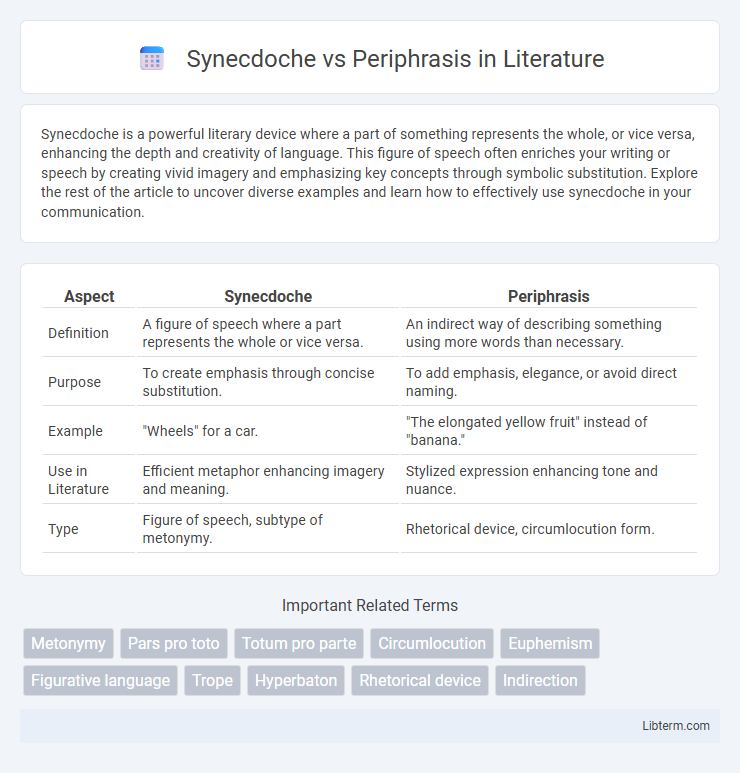Synecdoche is a powerful literary device where a part of something represents the whole, or vice versa, enhancing the depth and creativity of language. This figure of speech often enriches your writing or speech by creating vivid imagery and emphasizing key concepts through symbolic substitution. Explore the rest of the article to uncover diverse examples and learn how to effectively use synecdoche in your communication.
Table of Comparison
| Aspect | Synecdoche | Periphrasis |
|---|---|---|
| Definition | A figure of speech where a part represents the whole or vice versa. | An indirect way of describing something using more words than necessary. |
| Purpose | To create emphasis through concise substitution. | To add emphasis, elegance, or avoid direct naming. |
| Example | "Wheels" for a car. | "The elongated yellow fruit" instead of "banana." |
| Use in Literature | Efficient metaphor enhancing imagery and meaning. | Stylized expression enhancing tone and nuance. |
| Type | Figure of speech, subtype of metonymy. | Rhetorical device, circumlocution form. |
Introduction to Synecdoche and Periphrasis
Synecdoche is a figure of speech in which a part of something is used to represent the whole, such as "wheels" referring to a car, emphasizing direct and concise substitution. Periphrasis involves the use of longer, indirect expressions or circumlocutions to convey meaning, often replacing simple terms with more elaborate descriptions. Understanding these rhetorical devices enhances comprehension of language nuances and effective communication in literature and speech.
Defining Synecdoche: Meaning and Examples
Synecdoche is a figure of speech where a part of something represents the whole or vice versa, such as using "wheels" to refer to a car or "boots" to indicate soldiers. It functions by emphasizing a specific component to evoke the entire entity, enhancing vividness and connection in language. Examples include expressions like "all hands on deck" to call for everyone's assistance or "the crown" to denote royal authority, illustrating the power of representation through parts or wholes.
Understanding Periphrasis: Meaning and Usage
Periphrasis involves using a longer phrase or indirect expression instead of a simple word or phrase to convey meaning, often enhancing clarity or stylistic effect. It is commonly employed in literature and rhetoric to add emphasis, avoid repetition, or introduce formality, such as saying "the elongated yellow fruit" instead of "banana." Unlike synecdoche, which substitutes a part for a whole or vice versa, periphrasis expands on the concept through descriptive language rather than using a related term.
Key Differences Between Synecdoche and Periphrasis
Synecdoche is a figure of speech where a part represents the whole or vice versa, such as using "wheels" to refer to a car, while periphrasis involves using a longer, indirect expression instead of a simple term, like saying "the king of the jungle" instead of "lion." Synecdoche functions through substitution based on a component-whole relationship, whereas periphrasis relies on descriptive circumlocution without implying part-to-whole connections. The key difference lies in synecdoche's reliance on a specific part-to-whole semantic link, contrasting with periphrasis's emphasis on elaboration and ornate phrasing.
Semantic Roles in Language and Literature
Synecdoche employs a part-whole relationship to represent an entity, where a component or subset stands for the entire concept, emphasizing the semantic role of specific referents within a discourse. Periphrasis uses descriptive circumlocution to convey meaning indirectly, highlighting semantic roles by expanding or rephrasing concepts for emphasis or stylistic effect. Both devices manipulate semantic roles to shape interpretation, with synecdoche focusing on hierarchical inclusion and periphrasis on semantic elaboration.
Functions of Synecdoche in Communication
Synecdoche functions as a powerful linguistic tool in communication by using a part to represent the whole or vice versa, enhancing vividness and economy of expression. It facilitates emphasis and emotional engagement by highlighting a specific aspect that resonates with the listener's experience. This figure of speech effectively conveys complex ideas succinctly, making messages more memorable and impactful in both literary and everyday contexts.
Functions of Periphrasis in Expression
Periphrasis enhances expression by using descriptive phrases to replace single words, adding emphasis and clarity to communication. It functions to elaborate concepts, evoke imagery, and circumvent repetition, enriching the text's stylistic depth. Unlike synecdoche, which substitutes a part for a whole or vice versa, periphrasis expands meaning through circumlocution, making ideas more vivid and nuanced.
Common Mistakes: Synecdoche vs Periphrasis
Common mistakes when distinguishing synecdoche from periphrasis often arise due to their reliance on indirect expression. Synecdoche involves using a part to represent the whole or vice versa, such as "wheels" to mean a car, while periphrasis circumvents direct terms through elaborate or roundabout phrasing. Confusing these two figures of speech typically stems from overlooking the presence of substitution by a related term in synecdoche versus the use of descriptive expression in periphrasis.
Practical Applications in Writing and Speech
Synecdoche enhances vividness in writing and speech by using a part to represent the whole, such as "wheels" for a car, making descriptions more concise and impactful. Periphrasis employs indirect or roundabout expressions to add emphasis or politeness, like saying "the elongated yellow fruit" instead of "banana," useful for stylistic variety and nuanced communication. Both devices improve engagement, with synecdoche offering immediacy and periphrasis allowing subtlety, crucial for effective storytelling, rhetoric, and persuasive discourse.
Conclusion: Importance of Recognizing the Distinction
Recognizing the distinction between synecdoche and periphrasis is crucial for precise language interpretation and effective communication. Synecdoche employs a part-to-whole relationship, enhancing vividness and conciseness, while periphrasis uses descriptive phrases to elaborate or soften meaning. Mastery of these rhetorical devices enriches analytical reading, enriches rhetorical skill sets, and improves nuanced expression in literary and everyday contexts.
Synecdoche Infographic

 libterm.com
libterm.com